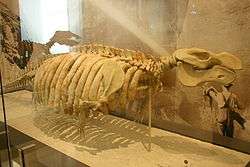Metaxytherium
| Metaxytherium | |
|---|---|
 | |
| M. floridanum fossil | |
| Scientific classification | |
| Kingdom: | Animalia |
| Phylum: | Chordata |
| Class: | Mammalia |
| Order: | Sirenia |
| Family: | Dugongidae |
| Genus: | Metaxytherium de Christol, 1840 |
| Species | |
| |
Metaxytherium is an extinct genus of dugong that lived from the Miocene to the Pleistocene. Fossil remains have been found in Africa, Asia, Europe, North America, and South America (Paraná Formation, Argentina, Pirabas Formation, Brazil and Montera Formation, Peru).
Taxonomy

There are eight species of Metaxytherium recognized as valid: M. albifontanum, M. arctodites, M. crataegense, M. floridanum, M. krahuletzi, M. medium, M. serresii, and M. subapenninum.
The genus Thalattosiren Sickenberg 1928 was once thought to be distinct from Metaxytherium, but is now considered a junior synonym of M. medium.[2]
Evolution
The relict species M. subapenninum represents the last stage of evolution of Metaxytherium, showing an increase in body size and in tusk size and a rostral reinforcement responding to a long-term climatic cooling.[3] These aquatic herbivores lived in warm coastal waters and inland waterways, feeding on seagrass.[4] Metaxytherium subapenninum lived in the early and late Pliocene of Italy and Spain (age range: 3.6 to 2.588 million years ago).[4] It is the only species of sirenians that lived in the northwestern coasts of the Mediterranean Sea in the Pliocene. It disappeared from the Mediterranean around 3 million years ago because of the progressive climate cooling. Fossils of these dugongs have been found, from the second half of the nineteenth century, in Piedmont, Emilia-Romagna, Liguria and Tuscany.[5][6][7][8][9]
Paleobiology
Metaxytherium lived in coastal waters and inland waterways, and there is evidence that they were preyed on by sharks.[10]
See also
Related species
References
- ↑ Jorge Vélez-Juarbe and Daryl P. Domning (2014). "Fossil Sirenia of the West Atlantic and Caribbean region. Ix. Metaxytherium albifontanum, sp. nov.". Journal of Vertebrate Paleontology 34 (2): 444–464. doi:10.1080/02724634.2013.799072.
- ↑ D. P. Domning and P. Pervesler. 2012. The sirenian Metaxytherium (Mammalia: Dugongidae) in the Badenian (Middle Miocene) of Central Europe. Austrian Journal of Earth Sciences 105(3):125-160
- ↑ Silvia Sorbi, Daryl P. Domning, Stefano Claudio Vaiani and Giovanni Bianucci Metaxytherium subapenninum (Bruno, 1839) (Mammalia, Dugongidae), the Latest Sirenian of the Mediterranean Basin Journal of Vertebrate Paleontology 32(3):686-707. 2012
- 1 2 Paleobiology Database
- ↑ GAMPS La sirena Plioenica
- ↑ Paleontologia: trovato fossile sirenio di 5 milioni anni fa
- ↑ La Nazione - Ha 5 milioni di anni il fossile trovato nel grossetano
- ↑ Quando inMaremma nuotavano le mucche di mare
- ↑ Il Tirreno - Scoperto lo scheletro di una "sirena" di cinque milioni di anni fa
- ↑ "METAXYTHERIUM TUSK FOSSILS". Paleo Direct, Inc. Archived from the original on 6 June 2013. Retrieved 26 June 2013.
Further reading
- Manatees and Dugongs of the World by Jeff Ripple
- Discovering Fossils: How to Find and Identify Remains of the Prehistoric Past (Fossils & Dinosaurs) by Frank A. Garcia, Donald S. Miller, and Jasper Burns
- Encyclopedia of Marine Mammals by William F. Perrin, Bernd Wursig, and J. G.M. Thewissen
- Marine Mammals: Evolutionary Biology by Annalisa Berta, James L. Sumich, and Kit M. Kovacs
- Marine Mammal Biology: An Evolutionary Approach by A. Rus Hoelzel
- Neptune's Ark: From Ichthyosaurs to Orcas by David Rains Wallace
- Classification of Mammals by Malcolm C. McKenna and Susan K. Bell
External links